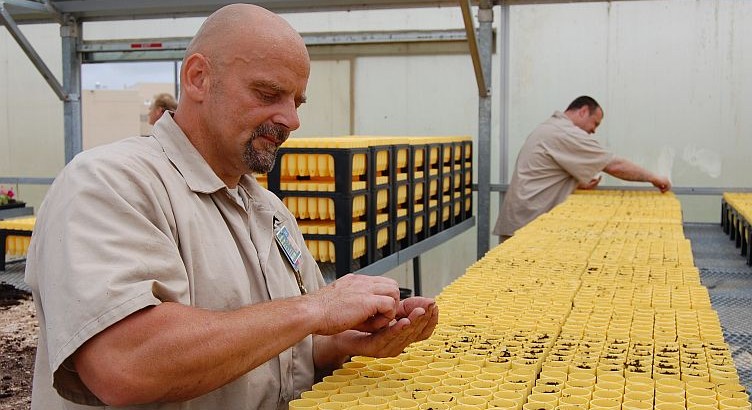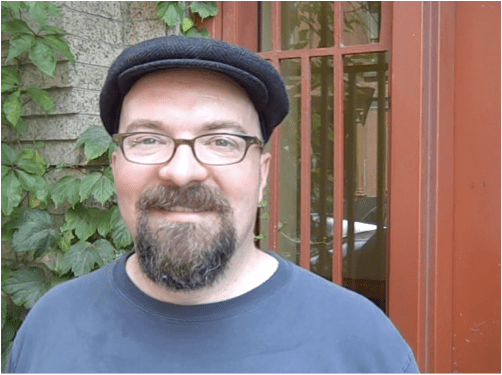This marks the first of a series of interviews with people working to make U.S. communities smarter, greener spaces. Got a suggestion for an interviewee? Send it our way or leave it in the comments section below.
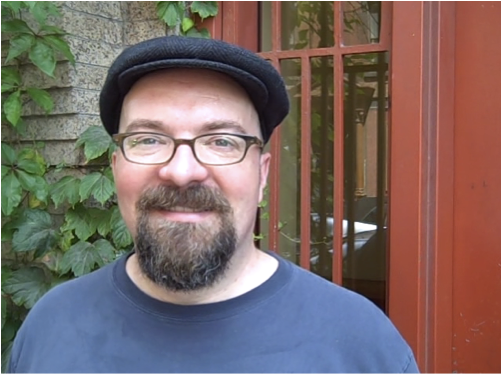 Tim Halbur’s career has included a stint as a journalist for NPR, co-producer of an environmental-justice driving tour of California’s I-5, and founder of an online media production company whose clients ranged from HarperCollins to the American Institute of Architects. With a masters in urban and regional planning, Tim puts his obsession to work every day as managing editor of Planetizen, which recently released a two-DVD set called The Story of Sprawl. It’s a weirdly compelling collection of short films from the 1930s through the ’60s focused on cities and transportation, with commentary from the likes of Andrés Duany and James Howard Kunstler. We checked in with Tim to find out how the DVDs came about, which cities he thinks are the smartest, and what urban-planning changes he’d make if he could wave his magic wand.
Tim Halbur’s career has included a stint as a journalist for NPR, co-producer of an environmental-justice driving tour of California’s I-5, and founder of an online media production company whose clients ranged from HarperCollins to the American Institute of Architects. With a masters in urban and regional planning, Tim puts his obsession to work every day as managing editor of Planetizen, which recently released a two-DVD set called The Story of Sprawl. It’s a weirdly compelling collection of short films from the 1930s through the ’60s focused on cities and transportation, with commentary from the likes of Andrés Duany and James Howard Kunstler. We checked in with Tim to find out how the DVDs came about, which cities he thinks are the smartest, and what urban-planning changes he’d make if he could wave his magic wand.
Q. What’s your occupation, and what does your work look like on a day-to-day basis?
A. I’m managing editor of Planetizen.com, a news and information website for the urban planning, design, and development community. My average day involves trawling the web for news I think will be of interest to our audience, editing opinion pieces by experts in the field, and putting together our books and DVDs.
Q. You recently compiled and released a two-DVD set called The Story of Sprawl — how did that come about, and how is it being received? Were there any surprises along the way?
A. I found a film a few years back called “Give Yourself the Green Light.” It was produced by General Motors in 1954 to advocate for building more and better highways. And regardless of the propagandistic element, it struck me as a fascinating snapshot of the time. You can see that as the population grew and people moved to the outskirts of cities, the existing road network wasn’t very efficient. But the roadbuilding that GM was promoting led to a brutal system of transportation planning that effectively cut the heart out of many of our cities.
So as I collected more films like “Green Light,” I began to see a story emerge about how sprawl happened that was richer than the one I’d learned in planning school. Eventually, I chose eight films that I think explain in detail why so many people abandoned cities, why the spread of major freeways and suburban housing happened so quickly, and the price we’ve paid for this disinvestment.
Q. The films in The Story of Sprawl paint a pretty dark picture of urban areas — busy, dirty, violent, poor, unhealthy — but they seem to also convey a bit of hope. In one, the narrator says, “If we plan well, urban Americans will someday enjoy more of the advantages of a large city without many of the penalties they now are forced to pay.” Do you think we’ve seen that promise fulfilled? Or is it still in the works?
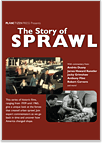 The Story of SprawlPlanetizen.comA. Well, I think the interesting thing about what these films show us is that the problems facing our cities are not new. The effect of the spread of suburbia and auto-oriented development was already dawning on urban thinkers by the early 1960s as they saw a disinvestment in downtowns and a growing lack of civic culture. Unfortunately, many of their solutions ended up being just as bad as the problem.
The Story of SprawlPlanetizen.comA. Well, I think the interesting thing about what these films show us is that the problems facing our cities are not new. The effect of the spread of suburbia and auto-oriented development was already dawning on urban thinkers by the early 1960s as they saw a disinvestment in downtowns and a growing lack of civic culture. Unfortunately, many of their solutions ended up being just as bad as the problem.
The picture of cities being dirty, violent, and poor is where I think the propaganda aspect of the films kicks in. Cities were certainly dirty with pollution through the period of the 1930s-’60s, which these films cover. And health issues were a reasonable concern with crowded conditions in big cities back in the early 20th century. But I believe these films were edited to make things look much worse, and again, the solutions they proposed were well-intentioned, but wrong. The issue of cities being “clean” led to the creation of those depressing housing projects with empty stretches of grass around them, where residents would supposedly enjoy being surrounded by a healthier atmosphere. Today we know better.
As to being able to enjoy the advantages of a large city without paying the penalties, I think in some ways yes: we’ve learned more about how to make downtown urban areas work well. But I also believe that there are always tradeoffs. As David Sucher, who wrote a book called City Comforts, put it, people today want an “urban village.” And those terms are in many ways contradictory. Urbanity means accepting some chaos, anonymity and proximity to strangers. Village life is about stability and community. You can work to bring aspects of both to city life, but city living is really a choice to embrace vibrancy, which includes a little chaos and grit.
Q. Which cities in the U.S. do you think are doing a particularly good job of becoming more livable, greener places?
A. Portland is the obvious answer. It has managed to create an “urban village” more than anywhere else in the U.S. But David Owen, a writer for The New Yorker, has made a persuasive argument that Manhattan is the greenest city around in his new book, Green Metropolis. The average New Yorker consumes about one-fourth the electricity a resident of Dallas uses, just from the advantages of a dense infrastructure and effective transit.
For me, density really is the underrated way to get green. I get frustrated seeing the focus on green building, when the same sort of 3,000-square-foot tract housing is being built and declared sustainable. We need to be focusing on designing high-quality, comfortable but relatively compact spaces that are unlike the cheap ’70s apartment buildings we’ve been plagued with so that people want to live together. There are tremendous social and environmental benefits to be had from living more densely.
Q. What has the Obama Administration done right so far for cities? What improvements would you like to see?
A. I think it’s too early to tell. The Administration has been a bit distracted by the end of society as we know it, so I don’t blame them for taking a slow approach to urban issues. The proposed high-speed rail corridors would be a big boon, and I hope they get built. Otherwise, they’re showing a good grasp of the issues and are rightly focusing on the regional perspective. Too many of today’s problems stem from the inability to create consensus among the various small governments in large metropolitan areas.
Q. If you could wave your magic wand and decree one big change in the world of urban planning and architecture, what would it be?
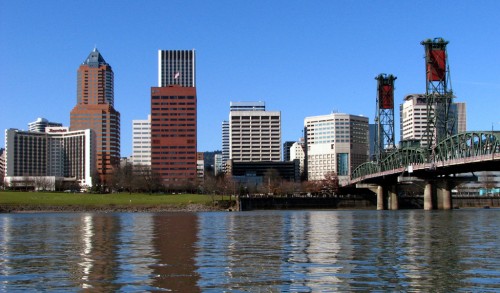 The City of Roses thinks regionally.A. Given my answer above, I’m tempted to change local governments to be more beholden to a regional elected authority. Portland has been able to make effective change … because the voters created a regional authority with teeth that could do things like create metro transit and enforce urban growth boundaries.
The City of Roses thinks regionally.A. Given my answer above, I’m tempted to change local governments to be more beholden to a regional elected authority. Portland has been able to make effective change … because the voters created a regional authority with teeth that could do things like create metro transit and enforce urban growth boundaries.
But being a utopian at heart, I’d really like to sweep my wand and try something more dramatic, like taking this “urban village” idea to the extreme and refashioning America’s cities into more functional structures. The problem with sprawl is that it destroyed the city/small town framework that worked so well. City planning is a delicate balance when practiced correctly. You can see that in cities in Europe that retain their forms. Each part of the city, from the countryside where food is produced to the economic heart of downtown, has its proper place in the structure. For the last 60 years, we’ve ignored all of that because cars got us everywhere.
Q. Where do you live, and what do you love about it? What would you change? Any suggestions for what people can do in their own neighborhoods?
A. I live in a great neighborhood in Los Angeles now, near one of my favorite urban public spaces, the Fairfax Farmers’ Market. It’s a series of small stalls that house delicious food stands, produce, and knickknacks, and it’s been there since the 1930s. I’m new to L.A., and I’ve really fallen in love with it. Tom Waits recently said that L.A. is “like a battery. It’s always plugged in.” I feel that since I’ve been here.
As to what people can do to create change in their neighborhoods, I’d say seek out your local community non-profit group focused on land use issues, and support the creation of walkable communities and better transit. Groups like TransForm in the San Francisco Bay Area and the Michigan Land Use Institute are big enough to make change on the local level, but not so big that they lose touch with their communities.
